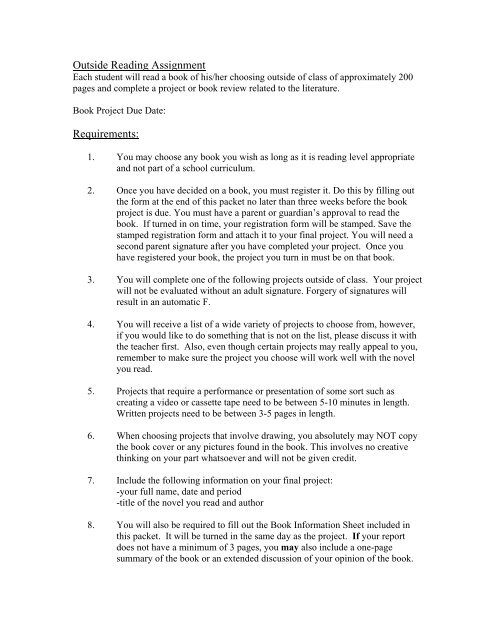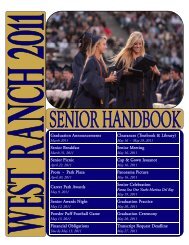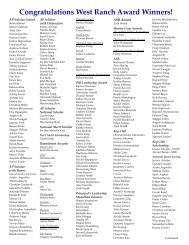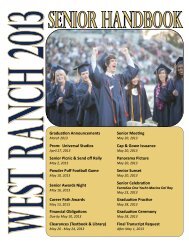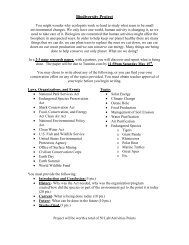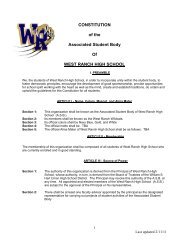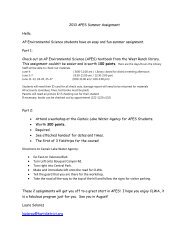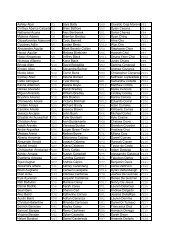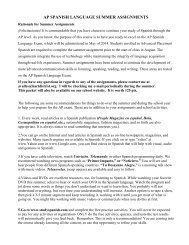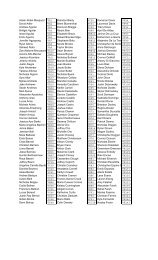English 9 Outside Reading List - West Ranch High School
English 9 Outside Reading List - West Ranch High School
English 9 Outside Reading List - West Ranch High School
Create successful ePaper yourself
Turn your PDF publications into a flip-book with our unique Google optimized e-Paper software.
<strong>Outside</strong> <strong>Reading</strong> Assignment<br />
Each student will read a book of his/her choosing outside of class of approximately 200<br />
pages and complete a project or book review related to the literature.<br />
Book Project Due Date:<br />
Requirements:<br />
1. You may choose any book you wish as long as it is reading level appropriate<br />
and not part of a school curriculum.<br />
2. Once you have decided on a book, you must register it. Do this by filling out<br />
the form at the end of this packet no later than three weeks before the book<br />
project is due. You must have a parent or guardian’s approval to read the<br />
book. If turned in on time, your registration form will be stamped. Save the<br />
stamped registration form and attach it to your final project. You will need a<br />
second parent signature after you have completed your project. Once you<br />
have registered your book, the project you turn in must be on that book.<br />
3. You will complete one of the following projects outside of class. Your project<br />
will not be evaluated without an adult signature. Forgery of signatures will<br />
result in an automatic F.<br />
4. You will receive a list of a wide variety of projects to choose from, however,<br />
if you would like to do something that is not on the list, please discuss it with<br />
the teacher first. Also, even though certain projects may really appeal to you,<br />
remember to make sure the project you choose will work well with the novel<br />
you read.<br />
5. Projects that require a performance or presentation of some sort such as<br />
creating a video or cassette tape need to be between 5-10 minutes in length.<br />
Written projects need to be between 3-5 pages in length.<br />
6. When choosing projects that involve drawing, you absolutely may NOT copy<br />
the book cover or any pictures found in the book. This involves no creative<br />
thinking on your part whatsoever and will not be given credit.<br />
7. Include the following information on your final project:<br />
-your full name, date and period<br />
-title of the novel you read and author<br />
8. You will also be required to fill out the Book Information Sheet included in<br />
this packet. It will be turned in the same day as the project. If your report<br />
does not have a minimum of 3 pages, you may also include a one-page<br />
summary of the book or an extended discussion of your opinion of the book.
9. Projects will be evaluated based on the following:<br />
-Timely registration of the novel you have chosen (5 pts.)<br />
-Parent or guardian signature (5 pts.)<br />
-Physical Appearance (neatness, organization, color, etc) (5 pts.)<br />
-Spelling and grammar (5 pts.)<br />
-Content & Detail (To what extent does this project prove to me that you read<br />
this book Does the final product reflect well thought-out ideas and<br />
demonstrate your understanding of the novel) (30 pts.)<br />
-Completed Book Information Sheet (10 pts.)<br />
Book projects:<br />
1. Children’s story<br />
Turn the novel you read into a children’s story by retelling the plot in a simple<br />
way with vocabulary appropriate for youngsters. Make sure your creation looks<br />
like a children’s book, complete with a hard cover, an appealing book jacket with<br />
the title and author, and colorful illustrations above and below your writing. Do<br />
NOT use lined paper, and make sure all writing is either typed or written neatly<br />
with a black marker.<br />
2. Write your own scene<br />
Write a scene that could have happened in the book you read, but didn’t. Be sure<br />
to write in the same style as the author. On a separate page, include a brief<br />
explanation of what has occurred up until this point in the novel and give a<br />
general description of the characters. In a second paragraph, explain why you<br />
made the changes you did and how they would have affected the outcome.<br />
3. Rewrite the ending<br />
If you did not care for the way your book ended then here is your opportunity to<br />
change it. Rewrite a new ending to the book you read. Be sure to write in the style<br />
of the author. Do NOT explain how the ending should be changed. Write as if you<br />
were writing the story. On a separate page describe the original ending and the<br />
changes you made and then explain why you made these changes. Include a<br />
Xerox copy of the last three pages of the novel you read.<br />
4. Map<br />
If the book you read involves a number of locations within a town, country or<br />
geographical area, create a colorful map. First make a list of all the locations –<br />
houses, stores, streets, parks, lakes, etc. mentioned in your book’s setting. Then<br />
draw the map showing a bird’s eye view of the area. Label each location. Below<br />
the map, create a legend with a list of all the locations. Include a one-page<br />
description explaining each item on the map and what important events occur at<br />
each location. Make sure your map has lots of details, is colorful, and is large<br />
enough to be seen clearly. All writing should be done in black ink or markers.
5. Test<br />
Create a test for the book you read. DO NOT USE ANYONE ELSE’S TEST<br />
QUESTIONS! Include a variety of kinds of questions such as true/false, multiple<br />
choice, matching, fill-in the blank, short answer, essay or any other kind of<br />
question. Be creative, but you must have a total of 50 questions, one of which<br />
must be an essay. The essay question should be broad enough to require (at least)<br />
a two-paragraph answer. Be sure to write clear directions for each section.<br />
Attach a completed answer key. (Do this by Xeroxing or printing out a second<br />
copy of the test and filling in your answers on the test, including the minimum<br />
requirements for a sample essay answer. These extra pages will not count against<br />
you.) Your test should be typed. Do not plagiarize.<br />
6. Comic Book<br />
Create a comic book based on the novel you read. It should have an illustrated<br />
cover with the title and author and be comic book size. Inside retell the story<br />
using dialog and descriptions of setting and characters. Put your writing in<br />
bubbles. Create colorful illustrations that help tell the story.<br />
7. Magazine<br />
Create a magazine that depicts the major events, controversial issues, and<br />
significant themes developed in the novel you read. Your project should<br />
realistically portray a professional magazine. All articles in your magazine must<br />
be typed and arranged in columns. If you cut and paste the columns onto the page,<br />
Xerox the final product. You will need a colorful front cover with the name of<br />
your magazine, date of edition, a picture that relates to your most important article<br />
and short descriptions of the kinds of articles featured in your magazine.<br />
Remember, EVERYTHING in your magazine needs to be related to the novel you<br />
read. You can have a “Dear Ann Landers” section with letters from characters<br />
asking for advice about their problems and responses of advice, articles related to<br />
significant events in the novel, advertisements, and anything else you might find<br />
in a magazine.<br />
8. Newspaper<br />
Create a front page to a newspaper that is devoted entirely to the book you read.<br />
The front page should look as much like a real newspaper as possible with writing<br />
in columns, headlines, a newspaper title, the main articles, etc. On the second<br />
page, you can include a variety of different kinds of features including horoscopes<br />
for each character, “Dear Ann Landers” letters, comic strips, advertisements,<br />
personal ads, an obituary section, or anything else you might find in a newspaper.<br />
Everything you include, however, must be based on events and characters in the<br />
book you read. Articles must be typed.<br />
9. Scrapbook<br />
Create a scrapbook for one of the main characters that reflects the many events<br />
that occur to him or her in the novel you read. You can include photographs,<br />
letters, post cards, telegrams, a family tree, newspaper article clippings,
memorable items or anything else you can think of that you might find in a<br />
scrapbook. If you include objects or photographs, be sure to write captions below<br />
describing what they are or what’s going on and their significance to the<br />
character. Create a nice cover for your scrapbook. On the inside, paste an<br />
information sheet identifying the full name of the character, his/her age (guess if<br />
you don’t know), birth date (if known), where he/she lives, and any other<br />
important information.<br />
10. Time Line<br />
Brainstorm a list of at least ten major events in the plot from beginning to end and<br />
then organize them, not in the order they are written, but in the order they would<br />
have happened if the events actually took place in real life. Create a time line<br />
using two pieces of computer paper. On your time line, write a short description<br />
of what happens for each event and, if possible, try to identify the time of each<br />
event with dates, seasons, etc. Add pictures and/or symbols for each event (10<br />
minimum) to make your time line colorful. All writing should be done in ink pen,<br />
marker, or typed and then taped neatly onto the paper.<br />
11. TV Talk Show<br />
Suppose the major characters from the novel you read are guests on a TV talk<br />
show like Ricki Lake, Oprah or Montel Williams, only you are the host. Develop<br />
a “hot” topic that these characters can all relate to (ex: for The Princess Bride you<br />
could use, “My husband tried to kill me”). You may want to even include the<br />
author as one of your guests or perhaps a counselor who can give advice to each<br />
character. Gather your friends to take on these roles and tape the show “live” on<br />
video. Remember to advise your friends to stay in role. Be sure to have a theme<br />
song to go with your show and mention the topic for your program. As talk show<br />
host, you will need to describe the topic and give background on what has<br />
happened to these characters. You will also need to introduce each character and<br />
ask probing questions that reveal who he/she is, how he/she is related to the other<br />
character(s), his/her beliefs, motivations (reasons for doing certain actions) and<br />
anything else of importance to your topic. Be sure to take questions from your<br />
audience or callers. Include at least one commercial break in your show (all<br />
commercial(s) must somehow relate to the novel you read). You are required to<br />
write a script and make sure each person who is in your video has a copy to study.<br />
Turn the script in with the videotape.<br />
12. Photo Album<br />
Seek out friends, family, teachers and classmates with a camera, ask them to<br />
pose in positions and places that reveal events in the novel you read, then shoot!<br />
Make sure your pictures are not just of people smiling and saying cheese though.<br />
Your pictures need to reveal EVENTS that occur in the novel. Use small props<br />
and costumes in your pictures to help identify who each character is and what is<br />
going on and try to choose models that resemble the characters. Once you have<br />
your pictures, arrange them in a photo album in the order the events occur.<br />
Below each, write a caption that explains who the people are, what is going on
and, if possible, the approximate date. Write the captions from the point of view<br />
of one of the main characters (ex: This is my best friend and I when we…). On<br />
the inside, paste an information sheet identifying the name of the character,<br />
his/her age (guess if you don’t know), birth date (if known), where he/she lives,<br />
and other important information about this person.<br />
13. Tour<br />
Imagine that you have been given the task of conducting a tour of the town in<br />
which the book you read is set. Make either a video or a cassette tape describing<br />
the homes of the characters and places where important events in the book took<br />
place. Plan to include brief chats with the novel’s characters along the way. Fill<br />
in your audience with any local rumors, town gossip, or any other interesting<br />
tidbits about the people that live there. Prepare by creating a script. Turn in this<br />
script along with your tape.<br />
14. Movie Preview<br />
The book you have read has just been made into a movie and you have been<br />
hired to create an interesting, attention –getting preview that will make<br />
moviegoers all across the country want to come see this new release. Prepare a<br />
script, practice and then videotape short scenes to be used for a preview.<br />
Remember previews should not reveal whole scenes, but instead, give us quick<br />
glimpses of what the movie is about. Use an attention getter at the beginning of<br />
your preview by having a narrator ask a question, describe a situation, etc. (just<br />
like when you write an attention getter for the introduction of an essay). Add<br />
appropriate background music that fits the mood or atmosphere of the overall<br />
movie. Be sure to videotape an interesting visual design of the title (to be shown<br />
at the end of the preview) and mention the actors and actresses who star in the<br />
feature film. (Turn in the script with this project!)<br />
15. Model of the Setting<br />
If the place where the story takes place is a significant part of the story, create a<br />
model of the setting. Create your model in either a large box, on a piece of<br />
cardboard or a piece of wood. Be sure to make it as realistic as possible. Include<br />
lots of details in your model that demonstrate events that occur in the novel you<br />
read. You may also want to include characters from your novel on the model you<br />
create. Label each place. On a piece of paper, write at least a one-page<br />
description of the setting and its significance to the rest of the story.<br />
16. Storytelling<br />
Turn the novel you read into an oral story that you tape on a cassette. Do NOT<br />
read from the novel, but instead, retell the story in your own words. On your<br />
tape, before you actually begin your story, introduce the title and author. Be sure<br />
to use appropriate tone and volume as well as special sound effects to help make<br />
your story more exciting! You might even want to use music. Develop a<br />
different voice for each of the main characters that “spoke” in your story. (Ex: If<br />
you were telling the story “Little Red Riding Hood,” when you came to the part
where Little Red says, “My what BIG teeth you have,” you would speak in a<br />
high-pitched voice and then switch to a much deeper, rough voice when the wolf<br />
responds, “All the better to eat you with.”) You will obviously have to skip parts<br />
of the story because a novel is very long. Create a script to use when you tell<br />
your story. Turn in the script with your tape.<br />
17. Diary<br />
Choose one main character from the novel you read and create a diary from<br />
his/her point of view that reveals all the major events in his/her life as well as<br />
this character’s feelings about these events including his/her hopes, dreams,<br />
problems, concerns and frustrations. Fill the diary with entries spread out over<br />
the entire period of time from the beginning of the novel to the end. Begin with<br />
“Dear Diary,” and write from the first person point of view (ex: Dear Diary,<br />
Today I went to see my best friend and we…). For each entry, if possible, write<br />
a date. Remember many dates of holidays can be checked on a calendar. If no<br />
dates are given, but seasons or other clues are given then guess an approximate<br />
date. Place your entries into a cover that you create, organizing them in the<br />
proper order. On the first page, include an information sheet identifying the full<br />
name of the character, his/her age (guess if you don’t know), birth date (if<br />
known), where he/she lives, and any other important information.<br />
18. Letters<br />
Write a series of letters that the characters may have sent to each other during the<br />
course of the novel. The letters need to reflect each character’s personality.<br />
Begin each letter with a greeting and end it with a closing. Write from the first<br />
person point of view. Place your letters into a cover that you create, organizing<br />
them in the proper order. On the first page, include an information sheet<br />
identifying the full names of the characters, their ages (guess if you don’t know),<br />
where they live, their relationship to each other, and any other important<br />
information.<br />
19. Movie/Book Comparison-Contrast Essay<br />
After reading the book, watch the movie version. On a piece of paper, type the<br />
name of the movie, year it was made, and the names of the stars playing the<br />
characters (it should look like a program). Attach this paper to your essay. You<br />
will need to type a five-paragraph essay comparing and contrasting three things<br />
between the movie and the book. Use specific details. You may write in first<br />
person. I expect you to share your opinion about which version you preferred and<br />
why. Please double space the essay and use size 14 font.
Name: ______________________________ Period: _____ Date: __________________<br />
Book Information Sheet<br />
1. Title: _____________________________________________________________<br />
2. Author: ___________________________________________________________<br />
3. Describe the setting of the story: _______________________________________<br />
_____________________________________________________________________<br />
4. Describe the main character: __________________________________________<br />
_____________________________________________________________________<br />
5. Describe the central conflict of the story: ________________________________<br />
_____________________________________________________________________<br />
6. Describe the resolution of the conflict: __________________________________<br />
_____________________________________________________________________<br />
7. In five sentences outline the plot of the story:<br />
1 st _______________________________________________________________<br />
__________________________________________________________________<br />
2 nd _______________________________________________________________<br />
__________________________________________________________________<br />
3 rd _______________________________________________________________<br />
__________________________________________________________________<br />
4 th _______________________________________________________________<br />
__________________________________________________________________<br />
5 th _______________________________________________________________<br />
__________________________________________________________________<br />
8. State the theme of the story: ___________________________________________<br />
9. Describe in detail why you liked or disliked the story: ______________________<br />
_____________________________________________________________________
Book Registration Form<br />
Student Name: _______________________________________________ Period: _____<br />
Book Title: ______________________________________________________________<br />
Author: _________________________________________________________________<br />
Number of pages: ____________ (divide this number by 30 = ________)<br />
I must read ________ pages a night to be finished in time.<br />
Parental approval of this book ________________________________________________________<br />
(parent signature #1)<br />
*****************************(do not separate)******************************************<br />
Book Project due date: ___________________________________<br />
Notice to parent: I certify that my child created this project after reading the above<br />
mentioned book. _____________________________________________________<br />
(parent signature #2)


